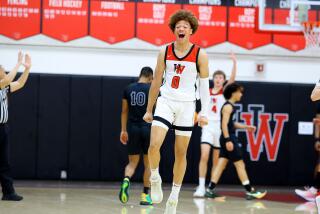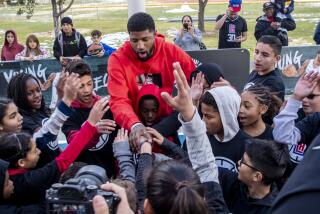UTEP’s Don Haskins Goes About Business Without the Fanfare
- Share via
EL PASO, Texas — He wears lumberjack shirts, baggy pants and cowboy boots to practice, rather than designer sweats and sneakers. He wears a clip-on tie to games, but it comes off the moment the band finishes the national anthem. He drives a pickup to work.
He has more victories (524) at one school, Texas El Paso, than all but one active Division I coach, North Carolina’s Dean Smith. Yet Don Haskins is much like Princeton’s Pete Carril, respected highly by his peers and virtually anonymous to the average college basketball fan.
“If that bothered me, I wouldn’t have stayed here all these years,” Haskins said while chewing on a toothpick while sitting in his office at the Special Events Center before a morning shoot-around. “I would have gone and got a bigger job. But I don’t think you should worry about something you never had.”
Not that Haskins never has been in the spotlight. It was 23 seasons ago that the man called “The Bear” took a team with five black starters to Cole Field House at the University of Maryland and beat an all-white Kentucky team for the national championship. The victory for Texas Western, as it was called, opened the eyes of coaches around the country.
“I wasn’t aware of it (the impact) when it happened,” said Haskins, 58. “Had they beaten us, it probably would have taken longer for blacks to get recruited. David Lattin, one of our guys, wanted to go to Houston, but they wouldn’t take him. The year after we won it, Elvin Hayes was at Houston.”
What opened Haskins’ eyes a bit was the response to his team’s victory. He received more than 40,000 pieces of mail from around the country, most of them spewing hate and making threats. The letters were not split along racial lines, either.
“I got mail from blacks, saying that I was exploiting black kids,” said Haskins. “And those letters from the whites in the South, you can just imagine what they said. It was discouraging, but you had to consider the source.”
Nearly a quarter-century later, Haskins doesn’t consider himself a pioneer or a legend. But others do. “To me, he’s the guy who opened the door for not only black players, but for black coaches, as well,” said Arkansas Coach Nolan Richardson, a junior here when Haskins arrived as a 31-year-old high school coach in 1961.
“What he did took a lot of guts. It took a big guy with a big heart. I’ve never said this publicly before, but I’ve never silently appreciated a man more for what he did than for what The Bear did. He taught me a hell of a lot, about basketball and about life.”
What Haskins taught, and continues to preach, on the court is that defense, tough, man-to-man defense, wins games. He turned Richardson from a gunner into a defensive stopper. Bobby Joe Hill, the leading scorer on the 1966 team, recalled what practices were like in those days.
“If you were a starter, you’d never play offense in practice,” said Hill, who works in the purchasing department at the local natural gas company. “We used to pray for the games. The practices were so hard that the games were easy.”
Haskins, too, was a one-dimensional, offensive player before he went to Oklahoma A&M; (now Oklahoma State) to play for the legendary Henry Iba in 1948. “When I got there, I couldn’t guard anybody,” he said. “But if you didn’t play defense for Mr. Iba, you didn’t play.”
The same holds true at UTEP. Though he’s been forced to use that dreaded, four-letter word (zone) in recent years, the fundamentals of it are in the slough-off, man-to-man defense Iba taught at Stillwater. “He really gets on you, especially on ‘D’,” said senior guard Tim Hardaway, this year’s star. “But he gets on you because he wants you to become disciplined.”
The talent has thinned a bit since his days coaching such players as Hill, Jim “Bad News” Barnes and Nate “Tiny” Archibald, but his Miners keep on winning. UTEP has won 22 games or more the past five seasons. The Miners were 8-1 going into Thursday night’s game against Cleveland State in the opening round of the John Hancock Sun Bowl tournament.
The advent of college basketball cable broadcasts, which helped the Big East become a power and strengthened the position of the Atlantic Coast Conference and the Big 10, has made it more difficult for programs such as UTEP to get blue-chip players. Hardaway was viewed as an academic risk coming out of a Chicago high school. Center Greg Foster transferred from UCLA.
“We were recruiting Anthony Allen out of Port Arthur (Texas), but the minute (Georgetown Coach) John Thompson showed up, it was all over,” said Haskins. “We’re on TV, but not back East. We have the biggest arenas in the country in our conference (Western Athletic) - we just don’t have the exposure.”
Aside from clean air and good Mexican food, the attraction at UTEP is Haskins. He doesn’t smooth-talk recruits the way North Carolina State’s Jim Valvano does. He isn’t a commanding presence the way Thompson is. He doesn’t have the big-time reputation of Smith or Louisville’s Denny Crum. He isn’t a burgeoning star, like Duke’s Mike Krzyzewski or Ohio State’s Gary Williams.
“I see him as an American folk hero, like Paul Bunyan or Jesse James,” said UTEP assistant Russ Bradburg, who, as a high school coach in Chicago, wrote Haskins six years ago and wound up coming to work for him. “He’s not on television a lot. He has an ability to push kids to the limit and to get the most of their talents.”
Haskins is a bit under-appreciated even on his campus. Former Miners football Coach Bob Stull, who recently left after three years to go coach at Missouri, reportedly was making more money than Haskins. Haskins came close to leaving twice in the late 1960s, once for another college job and the other time to coach the Dallas Chaparrals in the American Basketball Association.
The college job was at the University of Detroit. “It was totally because of money,” Haskins said of a job that eventually went to a then-unknown assistant coach at Rutgers named Dick Vitale. “That’s not a very solid reason. Did I think I’d be here this long? It’s like any job. Time takes care of things.”
Time hasn’t done much to change Haskins. A few more pounds, fewer hairs and a few more wins. But down to the toothpick jutting out the side of his mouth, down to the pickup truck parked outside, he’s pretty much the same country boy who came lumbering into town like a big old Bear from Dumas all those years ago.
More to Read
Go beyond the scoreboard
Get the latest on L.A.'s teams in the daily Sports Report newsletter.
You may occasionally receive promotional content from the Los Angeles Times.










